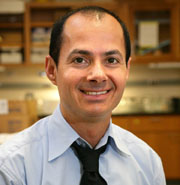|
||||||||||||||
The design and construction of chemical structures is at the heart of what chemist do, however, it remains more of an art than a science. This is largely due to the difficulty in predicting the outcome of chemical synthesis in particular those of large molecules and extended structures. To accomplish the synthesis of structures by design, it is important (1) to control the orientation (connectivity and geometry) of the building blocks in a targeted structure, and (2) to obtain the products in crystalline form so that their atomic arrangement can be definitively characterized by X-ray diffraction techniques. Indeed, the challenges are conceptual and practical in that one needs to know what structures might form from a given set of molecular building blocks and then find means of linking such building blocks into specific predetermined structures. My research group has been developing the conceptual as well as the practical aspects of constructing chemical structures using the concept of molecular building blocks. Our research has led to the invention of new classes of crystalline porous materials most notably ones that we call metal-organic frameworks (MOFs). In general, MOF structures have two main components: the organic linkers and the metal oxide units. The linkers act as ‘struts’ that bridge the metal oxide units which in turn act as ‘joints’ in the resulting MOF architecture. This arrangement inevitability produces porous structures for which we’ve shown that molecules can pass through the pores with preservation of the MOF structure. Since we reported the first porous MOFs in 1998 and 1999, over 2,000 three-dimensional structures have been reported by my group and others around the world. It is worth noting that to date there are more porous MOFs than porous zeolites or carbon materials, and MOFs have extraordinary surface areas (2,000-6,500) exceeding those of state-of-art materials. Furthermore, MOFs are stable in air at room temperature and withstand temperatures up to 450°C. They are made using simple, inexpensive and high yielding solution synthesis methods. These properties coupled with the flexibility with which one can vary the composition and metrics of the metal oxide units and the organic links of a given structure, have led to extensive investigation of MOFs in both academia and industry. At the heart of the matter is that we’ve shown for the first time that chemists are able to predictably assemble molecular building blocks into predetermined structures which can be functionalized and their metrics altered at will. We call this new kind of chemistry ‘reticular chemistry’ to emphasize that the dream of designing large and extended structure is becoming a reality. We define reticular chemistry as the chemistry dealing with linking of molecular building blocks, by strong bonds, into predetermined structures. It is worth discussing aspects of reticular chemistry here to point out the thinking involved in the design of new structures. In recent contributions we reported how the concept of secondary building units (SBUs) is being applied with eminent success to the design of highly porous and rigid MOF structures. Here, clusters such as those of the copper-carboxylate paddlewheel, Cu2(O2C-)4, and the octahedral basic zinc carboxylate, Zn4O(O2C-)6, have been used as rigid SBUs that respectively act as square and octahedral joints (i.e. vertices) in the framework. If the designer identifies the one step reaction conditions that reproducibly lead to such a particular SBU, then control of the vertex geometry in the resulting MOF is possible. Since the organic links remain intact and their geometry preserved throughout the assembly process, one should also be able to predict the underlying topology of the resulting MOF structure. However, the number of topologies that could, in principle, result from linking molecular shapes into extended MOF structures is vast—giving rise to three questions which my group is actively engaged in addressing: (1) From this large topology space, how do we as designers identify the most important topologies that should be considered in this chemistry? (2) How are they distributed among crystal structures already reported in the chemical literature? (3) How can these data be interpreted, organized, and classified for the purpose of developing systems of ‘grammar’ and ‘taxonomy’ that can lead to the design and construction of extended structures, the rationalization of existing structures, and the prediction of new ones? Our ability to design and synthesize a MOF structure nearly at will is being used to provide solutions to problems of energy storage (hydrogen and methane), carbon dioxide sequestration, separation of gases for medical uses, polymerization catalysis, highly selective and sensitive sensors, and countless others currently under investigation by my group and by chemical, automobile and electronic industries. We work closely with companies; an aspect that provides my group members (undergraduates and doctorate graduate students, postdoctoral fellows, and research fellows) with a unique experience of being engaged in a spectrum of projects involving basic science of design and synthesis, characterization of structure and porosity, and the feasibility of MOFs in various applications. The excitement of reticular chemistry and the ability to construct chemical structures from molecular building blocks has recently led us to create new classes of materials potentially as extensive as MOFs: metal-organic polyhedra (MOPs), zeolite imidazolate frameworks (ZIFs) and covalent organic frameworks (COFs). On a fundamental level, these classes of materials are produced by linking molecular building blocks through progressively stronger and stronger bonds, and doing so and still overcoming the ‘crystallization problem’. What kind of new chemistry and basic science concepts will these new materials inspire? What kind of new properties will be uncovered? What kind of new applications will be developed? And what immense pleasure will be derived in addressing these questions… A partial list of ongoing projects in the Yaghi research group is provided here.
Learn more about Prof. Yaghi in recent interviews published on the web: http://www.umich.edu/news/index.html?Releases/2005/Nov05/yaghi http://www.sciencewatch.com/nov-dec2004/sw_nov-dec2004_page3.htm
Metal-Organic
Frameworks 
A Covalent Organic Framework
Complete List of Publications is availabe on the Yaghi Group Web Site.
Department of Chemistry & Biochemistry
|

